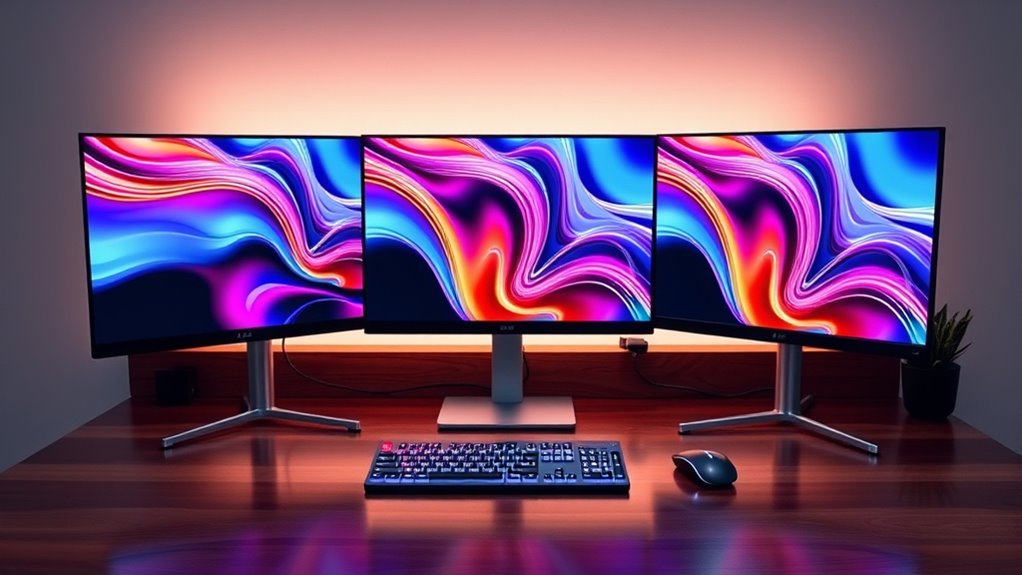To daisy chain monitors, you’ll need to ascertain your graphics card supports it and your monitors have DisplayPort MST capability. Connect the first monitor to your computer using a DisplayPort cable, then link the second monitor to the first monitor with another DisplayPort cable. Adjust your display settings for the best resolution and enjoy your expanded workspace. If you’re interested in troubleshooting common issues or optimizing your setup, there’s more to explore.
Understanding Daisy Chaining: What It Is and How It Works
When it comes to expanding your workspace, daisy chaining monitors can be a game changer. This technique allows you to connect multiple monitors in a series, using a single cable to reduce clutter and simplify your setup. One of the key daisy chaining benefits is the efficiency it brings—fewer cables mean more freedom to arrange your workspace as you like. However, monitor compatibility is essential; not all monitors support daisy chaining. Make sure your monitors have DisplayPort outputs and that they are configured correctly for peak performance. By understanding how daisy chaining works, you can create a seamless multi-monitor experience, enhancing your productivity and maximizing your visual real estate without sacrificing space or organization.
Essential Hardware Requirements for Daisy Chaining Monitors
To make the most of daisy chaining monitors, you’ll need to ascertain you have the right hardware in place. First, verify your graphics card supports daisy chaining; not all cards do. Look for ones with DisplayPort outputs, as this connection type is essential for linking multiple monitors. You’ll also need the right cable types—DisplayPort cables, specifically, are ideal for this setup. If you’re using USB-C monitors, confirm they also support DisplayPort Alt Mode for daisy chaining. Additionally, check that your monitors have DisplayPort Multi-Stream Transport (MST) capability. By meeting these hardware requirements, you’ll create a seamless multi-monitor experience that enhances your productivity and freedom in work or play.
Step-by-Step Guide to Daisy Chaining Your Monitors
Setting up your daisy-chained monitors can be straightforward if you follow these simple steps. First, verify your monitors support DisplayPort MST for proper monitor configuration. Connect the first monitor to your computer using a DisplayPort cable. Then, connect the second monitor to the first one using another DisplayPort cable.
Next, adjust the display resolution settings on your computer to match your desired layout. You can do this through your operating system’s display settings.
Here’s a quick reference table:
| Step | Action | Purpose |
|---|---|---|
| 1 | Connect first monitor | Establish base |
| 2 | Connect second monitor | Expand display area |
| 3 | Adjust display resolution | Optimize visibility |
Now you’re ready to enjoy your expanded workspace!
Troubleshooting Common Issues in Daisy Chaining
Even with the straightforward setup of daisy-chaining your monitors, you might encounter some common issues that can disrupt your experience. One frequent problem is signal loss, which can occur if the cables are too long or of poor quality. Verify you’re using high-quality DisplayPort cables that meet the necessary specifications. Compatibility issues can also arise; not all monitors support daisy chaining. Check the specifications of each monitor to confirm they have DisplayPort Multi-Stream Transport (MST) capabilities. If you’re still facing issues, try adjusting the display settings on your computer or restarting your devices. By troubleshooting these common problems, you can maintain a smooth and efficient multi-monitor setup.
Tips for Optimizing Your Multi-Monitor Setup
While optimizing your multi-monitor setup, it’s essential to contemplate both the physical arrangement and software settings. A smart monitor arrangement can greatly enhance your workspace efficiency. Here are a few tips:
| Tip | Description | Benefit |
|---|---|---|
| Positioning | Align monitors at eye level | Reduces neck strain |
| Resolution | Match resolutions across screens | Consistent visuals |
| Color Calibration | Verify colors are accurate | Better visual experience |
| Task Management | Use virtual desktops for organization | Improved focus |
Frequently Asked Questions
Can I Daisy Chain Monitors of Different Brands?
Yes, you can daisy chain monitors of different brands, but monitor compatibility is essential. Verify they support similar resolutions and refresh rates for ideal brand performance. Mixing brands may lead to inconsistent display quality.
What Is the Maximum Number of Monitors I Can Connect?
You can connect up to six monitors, like stars in a galaxy. Just guarantee your monitor specifications and connection types align for seamless integration. This way, you’ll create a stunning visual experience that feels limitless.
Will Daisy Chaining Affect My Computer’s Performance?
Daisy chaining monitors can slightly impact performance due to resource allocation, especially with higher resolutions. However, for most users, this effect is minimal, allowing you the freedom to enjoy an expanded workspace without significant drawbacks.
Can I Use Adapters for Incompatible Connections?
Sure, you can use adapters for incompatible connections, but it’s a bit like forcing a square peg into a round hole. Always check adapter compatibility with your connection types to avoid headaches down the line!
Do I Need Special Cables for Daisy Chaining?
Yes, you’ll need specific cable types that match the connection standards of your monitors. Confirm the cables support daisy chaining, like DisplayPort or Thunderbolt, to maximize your setup’s potential without compatibility issues.

